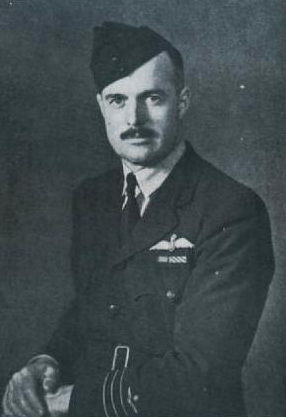
Wing Command Chad Martin, DSO, DFC.

Wing Commander C.(Chad) Martin, DFC, became the first airman product of the Empire Air Training scheme of any nationality to command a heavy bomber squadron. He was appointed to 460 squadron with instructions to do as many operations as possible in the early stages. He had done his first tour in 1941, as a member of 57 squadron, RAF, and seldom did the citation to an award sum up a man's personality and character as Chad Martin's did when he was awarded the DFC.
"The squadron's 26 Lancasters stood at the dispersals on the 8th July, 1943, bombed up and ready to go when at 6 p.m. the alarm sounded and through an electrical short circuit the entire bomb load of one Lancaster was released and fell to the ground, causing the incendiaries to burn.
Two of the ground staff were inside the bomber at the time and they leapt out and tried to roll the 4,000lb (cookie) bomb away, but found it was hopeless and ran for safety. They had the incendiaries among the other aircraft, and knocking the two escaping airmen to the ground. The Lancaster standing in the next dispersal point burst into flames and about two minutes later its bomb load exploded throwing more incendiaries among the aircraft and setting fire to starter trollies and other equipment nearby.
With several airmen, Wing Commander Martin manned the fire tender and extinguished as many of the incendiaries as possible, until someone saw smoke pouring from another Lancaster. Martin together with Flight Sergeant A. E. Kan. the latter still shocked from the original explosion, climbed inside the smoking bomber and fought the flames with hand extinguishers.
When the fire was partly under control another airman climbed in and disconnected the electrical leads to prevent more bombs from dropping to the ground. By this time the fire was intense enough to cause the magnesium contents of the fuselage to flare up, and almost suffocated, the three men had to leap out.
Wing Commander Martin then climbed on top of the burning, fully laden bomber and stood there coolly directing operations until the flames were put out.
In half an hour the danger was past, and the ground crews began getting as many aircraft as possible ready for the night's operations. In spite of damaged runways and shrapnel torn bombers, 17 aircraft took of and bombed Cologne.
Group Captain Edwards, who had also been close to the scene of the mishap, swore that whilst going from one bomber to another in his staff car, he was doing about 50 and was passed by an RAF erk running from the danger area!!
With such courage being shown by the leaders it is no wonder that 460 squadron flyers set such outstanding records of service and of courage.